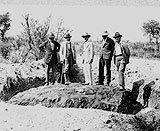Falls and finds
Every year between 30,000 and 80,000 meteorites larger than 20g in mass fall from space to Earth. These can be spectacular events.
Falls

An image taken from a video of the Peekskill fireball that fell in 1994.
Meteoroids, meteorites that travel through Earth's atmosphere before hitting the ground, can enter the atmosphere at speeds of over 11.2km per second.
As friction from our thick gassy atmosphere slows the meteoroid, it causes an intense heat, making the meteoroid appear like a fireball shooting across the sky. However, as the meteoroid slows further the fireball fades, making small meteoroids barely visible from an altitude of about 40km. This means that very few people actually witness a meteoroid hitting the ground and the resulting meteorite often goes unnoticed unless it causes damage.
Finds

Scientists with the Hoba meteorite which fell in Namibia in 1920 © W. T Gordon.
Generally, people do not see meteorites falling, but they recover them as finds. Most are relatively small, but the biggest to land as a single whole piece was 3m square, 1m high and weighed about 60 tonnes. Known as Hoba, it fell in Namibia and has become a national monument.
Many much larger meteorites have fallen leaving huge craters but are destroyed in the process. One of the biggest craters is called Chicxulub and forms a scar 180km across, under the sea in the Gulf of Mexico. Some scientists think it was the destructive force of this 10km-wide meteorite that led to the extinction of the dinosaurs 65 million years ago.
Many meteorites break up explosively during their passage through the atmosphere. They fall as a shower of stones within an elliptical area known as a strewn field, which can offer rich pickings for collectors.
Meteorites are also more abundant in dry places because the length of time they have been on Earth, their terrestrial residence age, can be higher.
Toolbox

There are 27 km of specimen shelves in the Darwin Centre - the same distance as between the Museum and Junction 6 of the M1.